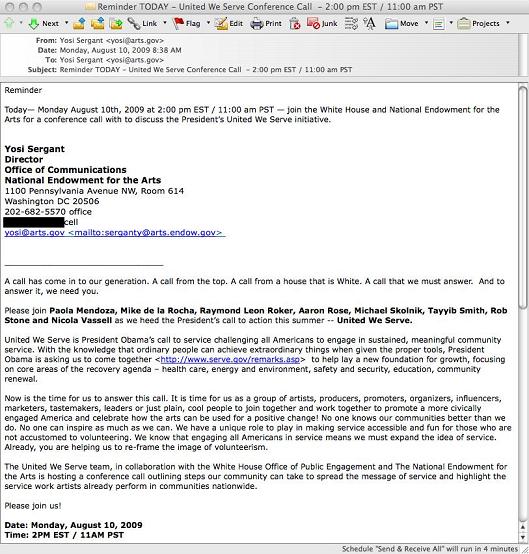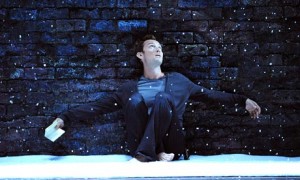What does it mean when a government official evades the truth?
On August 25th, I published an article discussing a conference call hosted by the National Endowment for the Arts (NEA), the White House Office of Public Engagement, and United We Serve that invited a group of art community luminaries “to help lay a new foundation for growth, focusing on core areas of the recovery agenda – health care, energy and environment, safety and security, education, community renewal.”
In the article I argued that it was not the role of the National Endowment for the Arts to use the arts to address specific issues, especially those of “health care” and “energy and environment” that are being vehemently debated nationally. I also clearly indicated that I was invited by the NEA and questioned their involvement in a meeting of this nature.
Two days later an article was published in the Washington Times that referenced my account of the conference call. Kerry Picket reported in the article that she “asked the NEA for a copy of the invitation to the conference call, but Communications Director for the NEA Yosi Sergant told us that they were not the ones who sent out the invitations for the conference call.” Picket continues, “Mr. Sergant directed us to the Corporation for National and Community Service as the body that sent out the invitations.”
Well, someone is playing loose with the facts. And let me say clearly here and now, it is not I. As can be clearly seen here, the invitation not only came from the National Endowment for the Arts, but from Sergant himself [click image to enlarge]:
Which leads me to my opening question: What does it mean when a government official evades the truth? Well, it typically means that the official, or the organization that they represent, has done something that may be considered questionable.
But the contradictions don’t stop there. On August 28th, Joshua Miller reported for Foxnews.com that Siobhan Dugan, a spokeswoman for the Corporation for National and Community Service, the very agency that Sergant claimed was responsible for the invitations, stated that the conference call “was organized by an ‘individual interested’ in the group and was unable to provide a list of those invited to participate on the call.”
So which is true? Did the National Endowment for the Arts initiate the meeting, was it the Corporation for National and Community Service, or was it the interested individual?
There is some confusion here. And it should be noted that I’m the only one that has provided proof with an invitation directly from the National Endowment for the Arts. Everything else is the Government’s word against mine, but the contradictions damage the Government’s credibility. Let me also enter here a “Reminder” email [see below, click to enlarge], again from the National Endowment for the Arts, which makes it abundantly clear who was calling the meeting at the onset of the email by stating “join the White House and National Endowment for the Arts for a conference call…”
Contradictions are revealing. In my opinion, the NEA is distancing the agency from initiating the conference call. And the only answer that I can extrapolate is that they understand the potential landmines associated with initiating a meeting of this nature.
Regardless of these obvious contradictions, it really doesn’t matter who originated the meeting. Yes, it appears that the government is distancing the NEA from being the meeting initiator. And yes, the NEA’s initiation of a meeting that encouraged the independent art community to address specific issues under current national debate may be a violation of its charter. But the mere fact that the National Endowment for the Arts participated in a conference call of this nature taints the agency and creative process moving forward. It is called the National Endowment for the Arts, not to use the Arts, a subtle but profound difference that the NEA appears to only now realize.
My fear has always been that by providing issues as a cynosure for inspiration to a handpicked arts group – a group that played a key role in the President’s election as mentioned throughout the conference call – the National Endowment for the Arts was steering the art community toward creating art on the very issues that are currently under contentious national debate; those being health care reform and cap-and-trade legislation. By organizing a community of this nature, the NEA has attempted to create a propaganda machine to push the administration’s political agenda, ultimately politicizing the agency.
And at this early stage it appears my fears were valid. Case in point is an announcement that I received from Rock the Vote on August 21st, a week and a half after the initial conference call. The contents of the announcement highlighted a “health care design contest” judged by N.E.R.D, Andrew W.K., and DJ Skee & Chester French. You may recall from my previous article that a representative from Rock the Vote was on the phone call. In the Foxnews.com article mentioned above, Thomas Bates, vice president of civic engagement for Rock the Vote, claimed that he didn’t agree with me that there was a political undercurrent to the meeting. Well, he may not have felt the undercurrent because he was part of the NEA pitch team creating it. A river doesn’t feel its own current.
Looking at Rock the Vote’s health care position, as published on their website, and the showcased design submissions [see the scroll in the upper right] you can see that my fears have become a reality. The artwork [examples below] came from their contest. Their announcement of the design contest states, “We can’t stand by and listen to lies and deceit coming from those who are against reforming a broken system…We need designs that tell the country YES WE CARE! Young people demand health care now.” On their home page they state, “Enough is Enough – Demand Health Care.” Their blog argues for a “public option.” Is there any question that the artwork and their campaign is not aligned with the administration’s policies? Is it just a coincidence that Rock the Vote participated in the conference call and their health care reform campaign came out around the same time? I think not.
In another example of the NEA stacking the deck, a conference call participant created the below [click to enlarge] black and white “Heal The Sick” poster (prior to the meeting) that argues for universal health care. He also had the image below on the homepage of his website (it’s been curiously replaced over the weekend). And a blog entry dated April 7, 2009 is entitled “give me socialism or give me death” that argues for universal health care. I don’t think there is any ambiguity as to what position he would take if prompted to create health care related art by the NEA.
No political undercurrent? Inviting a handpicked group from the art community that supported the President’s campaign and having them speak to issues will inevitably create an undercurrent.
In my opinion, this is a clear instance of the administration’s politicizing of the National Endowment for the Arts. A community organizing effort to use the apparatus of the government to push a political agenda has no place in the NEA. Art is powerful and therefore must be free of this apparatus or it can be used to manufacture consent.
Facts are bipartisan. Regardless of your political affiliation, it cannot be denied that the NEA asked a handpicked art community to create art that addressed issues being contentiously debated nationally. That is not the proper use of this federal agency. The National Endowment for the Arts should have never played a role in sculpting this effort. But instead their hands are caked with clay.
So now what?
It is clear that the NEA needs to answer some questions. They have not denied any of my notes transcribed from the meeting, but they appear to be deflecting inquiries at the present. So, I’d like you, the reader, to take two minutes out of your day and either call or email the National Endowment for the Arts (Chairman’s & PR Link) and ask them to issue a statement answering the following questions:
Did the NEA have anything to do with initiating the conference call?
Did the NEA encourage artists to create art on health care, energy and the environment?
Power is gained incrementally. A precedent such as this cannot be set because it will be grossly abused in the future if unchecked. Help me keep this agency in check so that we can resist the National Endowment for the Arts’ attempt at bringing the art community together “to speak with the government.” That’s a choir that should be left for totalitarian states.





COMMENTS
Please let us know if you're having issues with commenting.